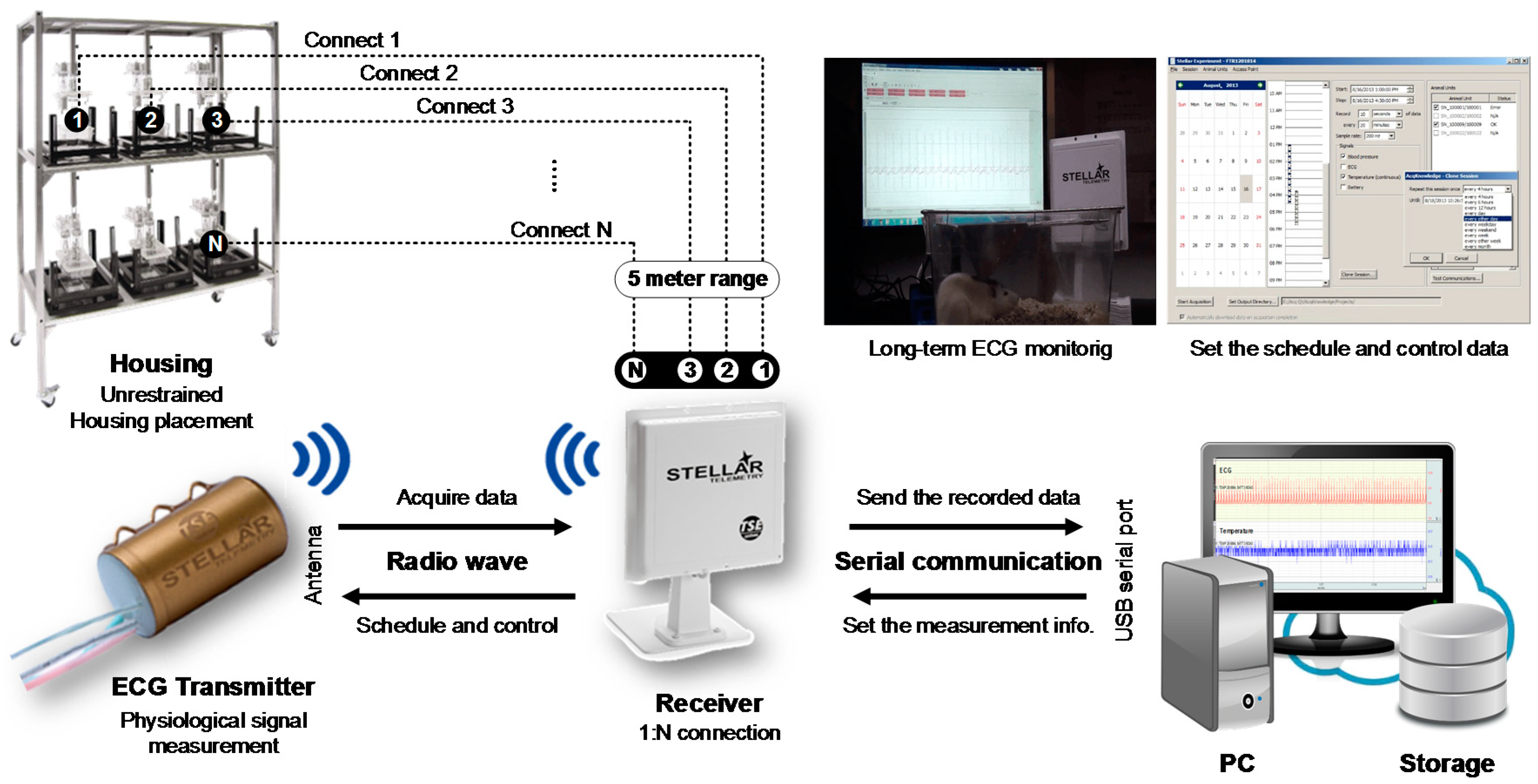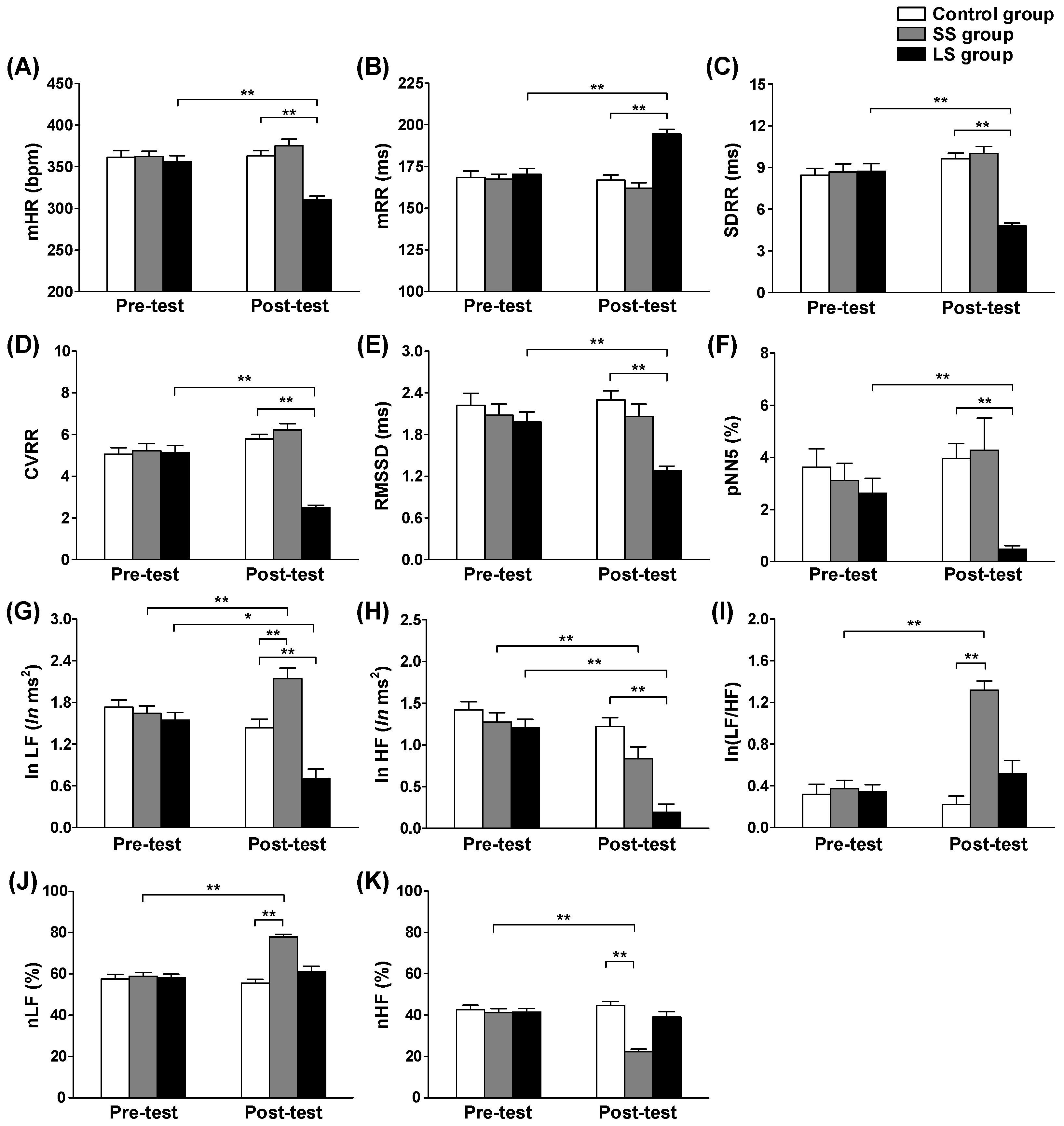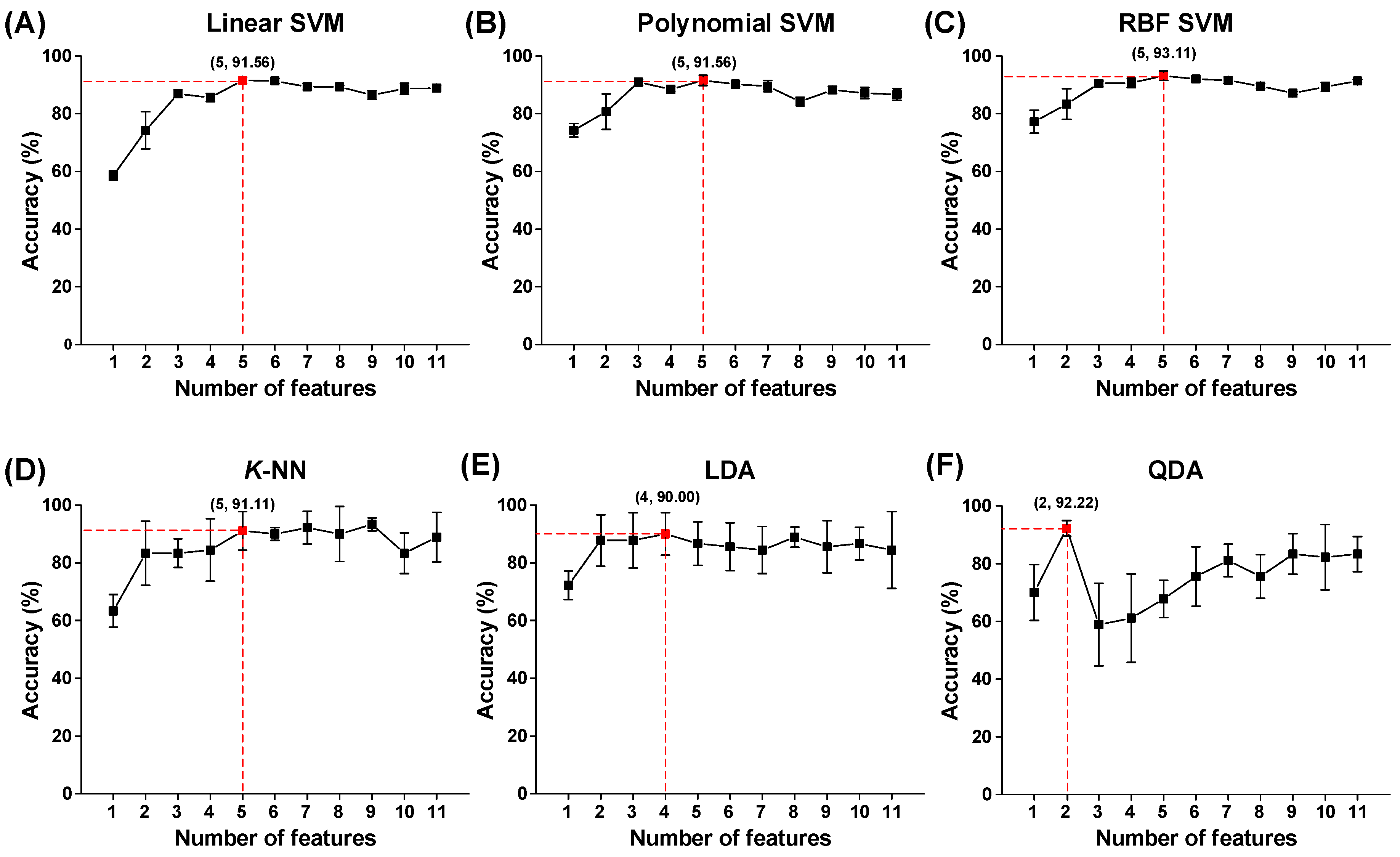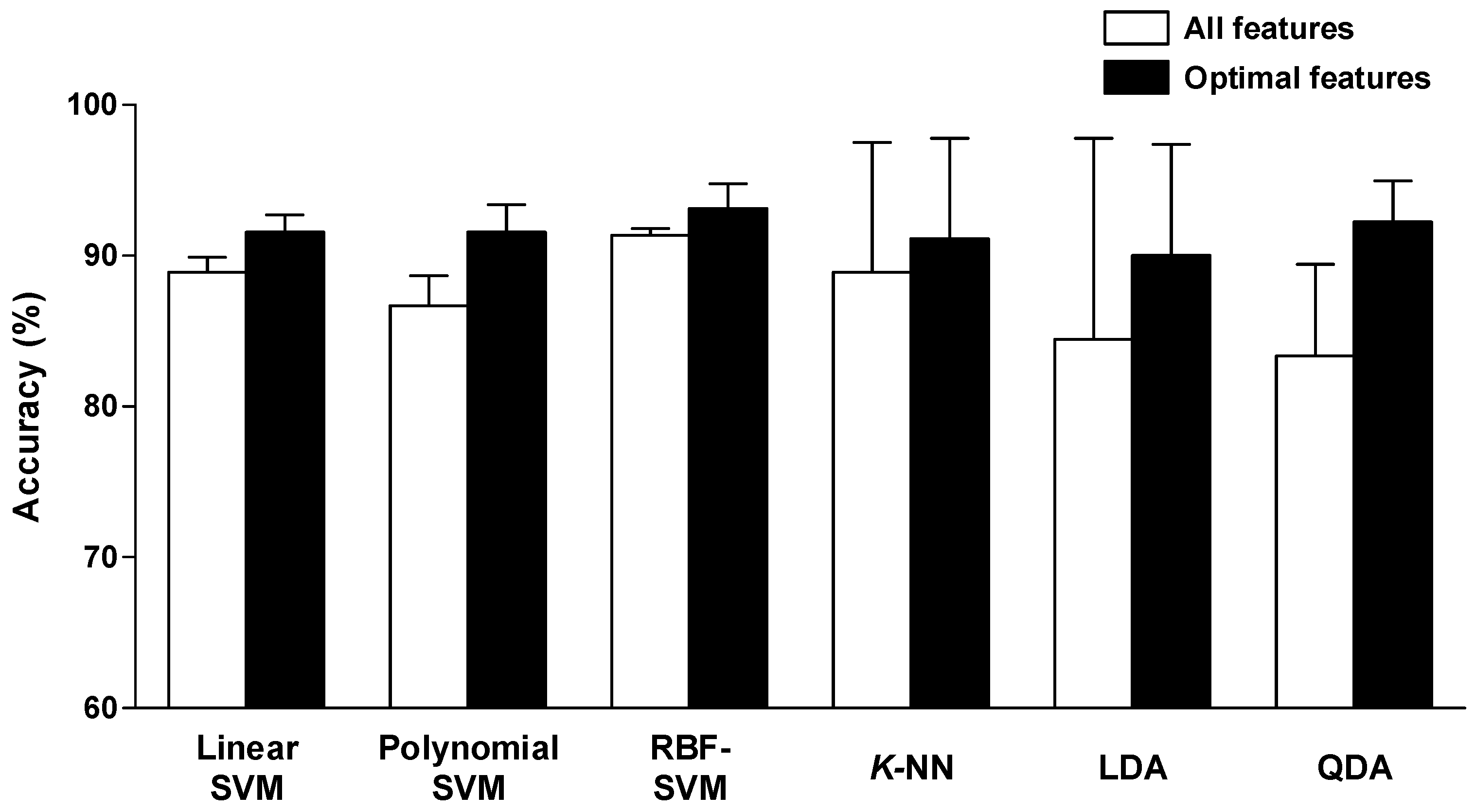Determination of Optimal Heart Rate Variability Features Based on SVM-Recursive Feature Elimination for Cumulative Stress Monitoring Using ECG Sensor
Abstract
:1. Introduction
2. Related Work
3. Materials and Methods
3.1. Experimental Study
3.1.1. Animals
3.1.2. Cumulative Stress Protocol
3.2. Radio-Telemetry System
3.3. Transmitter Implant Surgery
3.4. HRV Analysis
3.5. Support Vector Machine-Recursive Feature Elimination
3.5.1. Ranking Criterion Generation
3.5.2. Optimal Feature Subset Determination
3.6. Statistical Analysis
4. Results
4.1. Analysis of Effects of Short- and Long-Term Stress on HRV Features
4.2. Determination of Optimal Feature Sets on Various Classifiers
4.3. Comparison of Performances on Optimal Feature Sets
5. Discussion
5.1. Results Interpretation
5.2. Limitations and Future Works
6. Conclusions
Author Contributions
Acknowledgments
Conflicts of Interest
Ethical Statements
References
- Sajadieh, A.; Nielsen, O.W.; Rasmussen, V.; Hein, H.O.; Abedini, S.; Hansen, J.F. Increased heart rate and reduced heart-rate variability are associated with subclinical inflammation in middle-aged and elderly subjects with no apparent heart disease. Eur. Heart J. 2004, 25, 363–370. [Google Scholar] [CrossRef] [PubMed] [Green Version]
- Won, E.; Kim, Y.; Stress, K. The Autonomic Nervous System, and the Immune-Kynurenine Pathway in the Etiology of Depression. Curr. Neuropharmacol. 2016, 14, 665–673. [Google Scholar] [CrossRef] [PubMed]
- Hannibal, K.E.; Bishop, M.D. Chronic stress, cortisol dysfunction, and pain: A psychoneuroendocrine rationale for stress management in pain rehabilitation. Phys. Ther. 2014, 94, 1816–1825. [Google Scholar] [CrossRef] [PubMed]
- Kuh, D.; Ben-Shlomo, Y.; Lynch, J.; Hallqvist, J.; Power, C. Life course epidemiology. J. Epidemiol. Commun. Health 2003, 57, 778–783. [Google Scholar] [CrossRef] [Green Version]
- Task Force of the European Society of Cardiology. Heart rate variability: Standards of measurement, physiological interpretation, and clinical use. Circulation 1993, 93, 1043–1065. [Google Scholar] [CrossRef]
- Dixit, P.N.; Kishan, K.; Ramaswamy, C.; Raghavendra Babu, Y.P.; Ashoka, H.G.; Vinodini, N.A.; Chatterjee, K.; Bhargavi, C. Relative role of obesity and occupational hazards on autonomic modulation. Int. J. Biomed. Res. 2012, 3, 109–113. [Google Scholar]
- Kim, D.; Koo, H.; Lee, W.; Kim, M. Application and limitation of frequency domain, LF/HF component in heart rate variability as an acute stress index. In Proceedings of the International Conference on Biomedical Engineering and Systems, Prague, Czech Republic, 14–15 August 2014; p. 128. [Google Scholar]
- Lee, H.B.; Kim, J.S.; Kim, Y.S.; Baek, H.J.; Ryu, M.S.; Park, K.S. The relationship between HRV parameters and stressful driving situation in the real road. In Proceedings of the 2007 6th International Special Topic Conference on Information Technology Applications in Biomedicine, Tokyo, Japan, 8–11 November 2007; pp. 198–200. [Google Scholar]
- Guyon, I.; Elisseeff, A. An introduction to variable and feature selection. J. Mach. Learn. Res. 2003, 3, 1157–1182. [Google Scholar]
- Endukuru, C.K.; Tripathi, S. Evaluation of cardiac responses to stress in healthy individuals—A non invasive evaluation by heart rate variability and stroop test. Int. J. Sci. Res. 2016, 5, 286–289. [Google Scholar]
- Vargas-Luna, M.; Huerta-Franco, M.R.; Montes, J.B. Evaluation of the cardiac response to psychological stress by short-term ECG recordings: Heart rate variability and detrended fluctuation analysis. In Proceedings of the World Congress on Medical Physics and Biomedical Engineering, Beijing, China, 26–31 May 2013; pp. 333–335. [Google Scholar]
- Borchini, R.; Veronesi, G.; Bonxini, M.; Gianfagna, F.; Dasho, O.; Ferrario, M.M. Heart Rate Variability Frequency Domain Alterations among Healthy Nurses Exposed to Prolonged Work Stress. Int. J. Environ. Res. Public Health 2018, 15, 113. [Google Scholar] [CrossRef] [PubMed]
- Ollander, S.; Godin, C.; Charbonnier, S.; Campagne, A. Feature and Sensor Selection for Detection of Driver Stress. In Proceedings of the 3rd International Conference on Physiological Computing Systems, Lisbon, Portugal, 27–28 July 2016; pp. 115–122. [Google Scholar]
- Dobbins, C.; Fairclough, S. Detecting Negative Emotions During Real-Life Driving via Dynamically Labelled Physiological Data. In Proceedings of the 2018 IEEE International Conference on Pervasive Computing and Communications, Athens, Greece, 19 March 2018. [Google Scholar]
- Aigrain, J.; Spodenkiewicz, M.; Dubuisson, S.; Detyniecki, M.; Cohen, D.; Chetouani, M. Multimodal stress detection from multiple assessments. IEEE Trans. Affect. Comput. 2016, 14. [Google Scholar] [CrossRef]
- Choi, M.; Koo, G.; Seo, M.; Kim, S.W. Wearable Device-Based System to Monitor a Driver’s Stress, Fatigue, and Drowsiness. IEEE Trans. Instrum. Meas. 2018, 67, 634–645. [Google Scholar] [CrossRef]
- Papp, M.; Willner, P.; Muscat, R. An animal model of anhedonia: Attenuation of sucrose consumption and place preference conditioning by chronic unpredictable mild stress. Psychopharmacology 1991, 104, 255–259. [Google Scholar] [CrossRef] [PubMed]
- Gambarana, C. Experimental Protocols for the Study of Stress in Animals and Humans. In Nutrients, Stress, and Medical Disorders, Nutrition and Health; Yehuda, S., Mostofsky, D.I., Eds.; Human Press: New York, NY, USA, 2006; pp. 21–35. ISBN 978-1-58829-432-6. [Google Scholar]
- De Pablos, R.M.; Sarmiento, M.; Espinosa-Oliva, A.M. Creating a Rat Model of Chronic Variate Stress. J. Neuroinflamm. 2014, 4. [Google Scholar] [CrossRef]
- Grønli, J.; Murison, R.; Bjorvatn, B.; Sørensen, E.; Portas, C.M.; Ursin, R. Chronic mild stress affects sucrose intake and sleep in rats. Behav. Brain Res. 2004, 150, 139–147. [Google Scholar] [CrossRef]
- Bhatia, V.; Rarick, K.R.; Stauss, H.M. Effect of the data sampling rate on accuracy of indices for heart rate and blood pressure variability and baroreflex function in resting rats and mice. Physiol. Meas. 2010, 31, 1185–1201. [Google Scholar] [CrossRef] [PubMed]
- Guyon, I.; Weston, J.; Barnhill, S.; Vapnik, V. Gene selection for cancer classification using support vector machines. Mach. Learn 2002, 46, 389–422. [Google Scholar] [CrossRef]
- Junli, C.; Licheng, J. Classification mechanism of support vector machines. In Proceedings of the 5th International Conference on Signal Processing, Beijing, China, 21–25 Auguste 2000; pp. 1556–1559. [Google Scholar]
- Stubsjøen, S.M.; Knappe-Poindecker, M.; Langbein, J.; Fjeldaas, T.; Bohlin, J. Assessment of chronic stress in sheep (part II): Exploring heart rate variability as a non-invasive measure to evaluate cardiac regulation. Small Rumin. Res. 2015, 133, 30–35. [Google Scholar] [CrossRef]
- Frey, B.; Binder, T.; Teufelsbauer, H. Heart rate variability and patient outcome in advanced heart failure. J. Am. Coll. Cardiol. 1993, 21, 286A. [Google Scholar]
- Liu, G.; Wang, L.; Wang, Q.; Zhou, G.; Wang, Y.; Jiang, Q. A new approach to detect congestive heart failure using short-term heart rate variability measures. PLoS ONE 2014, 9, e93399. [Google Scholar] [CrossRef] [PubMed]
- Vanitha, L.; Suresh, G.R.; Punita, P. Development of four stress levels in group stroop colour word test using HRV analysis. Biomed. Res. 2017, 28, 98–105. [Google Scholar]
- Okada, Y.; Yoto, T.Y.; Suzuki, T.; Sakuragawa, S.; Sakakibara, H.; Shimoi, K.; Sugiura, T. Wearable ECG Recorder with Acceleration Sensors for Monitoring Daily Stress. J. Med. Biol. Eng. 2012, 33, 420–426. [Google Scholar] [CrossRef]
- Mohan, P.M.; Nagarajan, V.; Das, S.R. Stress measurement from wearable photoplethysmographic sensor using heart rate variability data. In Proceedings of the International Conference on Communication and Signal Processing, Aurangabad, India, 6–8 April 2016. [Google Scholar]
- Reyes del Paso, G.A.; Langewitz, W.; Mulder, L.J.; van Roon, A.; Duschek, S. The utility of low frequency heart rate variability as an index of sympathetic cardiac tone: A review with emphasis on a reanalysis of previous studies. Psychophysiology 2013, 50, 477–487. [Google Scholar] [CrossRef] [PubMed]
- Boonnithi, S.; Phongsuphap, S. Comparison of heart rate variability measures for mental stress detection. In Proceedings of the Computing in Cardiology, Hangzhou, China, 18–21 September 2011; pp. 85–88. [Google Scholar]
- Sacha, J. Why should one normalize heart rate variability with respect to average heart rate. Front. Physiol. 2013, 4, 306. [Google Scholar] [CrossRef] [PubMed]
- Campos, A.C.; Fogaca, M.V.; Aguiar, D.C.; Guimaraes, F.S. Animal models of anxiety disorders and stress. Rev. Bras. Psiquiatr. 2013, 35, S101–S111. [Google Scholar] [CrossRef] [PubMed]
- McEwen, B.S. Protection and damage from acute and chronic stress: Allostasis and allostatic overload and relevance to the pathophysiology of psychiatric disorders. Ann. N. Y. Acad. Sci. 2004, 1032, 1–7. [Google Scholar] [CrossRef] [PubMed]
- Skelin, I.; Kovačević, T.; Diksic, M. Neurochemical and behavioural changes in rat models of depression. Croat. Chem. Acta 2011, 84, 287–299. [Google Scholar] [CrossRef]
- Arnesen, A.R. Fibre population of the vestibulocochlear anastomosis in humans. Acta Oto-laryngol. 1984, 98, 501–518. [Google Scholar] [CrossRef]
- Da Silva Carvalho, C.; Sato, K.L.; Castania, J.A.; Salgado, H.C.; Nessler, R.A. Ultrastructural Morphometry of the Aortic Depressor Nerves and Extrinsic Renal Nerves: Similarities and Differences between Mice and Rats. Anat. Physiol. 2014, 4. [Google Scholar] [CrossRef]








© 2018 by the authors. Licensee MDPI, Basel, Switzerland. This article is an open access article distributed under the terms and conditions of the Creative Commons Attribution (CC BY) license (http://creativecommons.org/licenses/by/4.0/).
Share and Cite
Park, D.; Lee, M.; Park, S.E.; Seong, J.-K.; Youn, I. Determination of Optimal Heart Rate Variability Features Based on SVM-Recursive Feature Elimination for Cumulative Stress Monitoring Using ECG Sensor. Sensors 2018, 18, 2387. https://doi.org/10.3390/s18072387
Park D, Lee M, Park SE, Seong J-K, Youn I. Determination of Optimal Heart Rate Variability Features Based on SVM-Recursive Feature Elimination for Cumulative Stress Monitoring Using ECG Sensor. Sensors. 2018; 18(7):2387. https://doi.org/10.3390/s18072387
Chicago/Turabian StylePark, Dajeong, Miran Lee, Sunghee E. Park, Joon-Kyung Seong, and Inchan Youn. 2018. "Determination of Optimal Heart Rate Variability Features Based on SVM-Recursive Feature Elimination for Cumulative Stress Monitoring Using ECG Sensor" Sensors 18, no. 7: 2387. https://doi.org/10.3390/s18072387
APA StylePark, D., Lee, M., Park, S. E., Seong, J.-K., & Youn, I. (2018). Determination of Optimal Heart Rate Variability Features Based on SVM-Recursive Feature Elimination for Cumulative Stress Monitoring Using ECG Sensor. Sensors, 18(7), 2387. https://doi.org/10.3390/s18072387




